Oregon regulators last week voted to move ahead with a formal rulemaking to amend utility wildfire mitigation plans despite the utilities’ concerns about a key provision in the proposed ruleset related to pole inspections on distribution lines.
The decision by the state’s Public Utility Commission (OPUC) on Jan. 18 comes after a six-month informal process in which OPUC staff worked with industry stakeholders and other concerned parties to draft rules for the commission to consider and eventually put to a vote (AR 638).
The commission’s formal proceeding typically allows for public input and deliberation intended to make modest adjustments to proposed rules already largely hashed out during the preceding informal process. But the AR 638 proceeding will likely entail heavier revisions and possible industry counterproposals regarding the pole inspection measures.
The updated wildfire rules come with a sense of urgency, as drier summers fueled by climate change put the heavily forested Pacific Northwest at increasing risk of catastrophic fires like those ignited over Labor Day weekend in September 2020.
It was just ahead of those fires that Portland General Electric (NYSE:PGE) invoked the state’s first ever public safety power shutoffs (PSPS) in the Mount Hood area southeast of Portland. (See High Fire Danger Prompts First Oregon PSPS Event.) Pacific Power and its parent company PacifiCorp (NYSE:BRK.A) face multiple lawsuits from residents who contend the utility should have done the same in Southern Oregon before the company’s power lines sparked four massive fires that together destroyed nearly 2,500 homes. (See PacifiCorp Faces Class Action over Wildfire Response.)
“These rules on wildfire mitigation are one of the commission’s most important missions,” OPUC Chair Megan Decker said during last week’s commission meeting.
More and Less Prescriptive
The amendments proposed by OPUC staff expand on existing rules (AR 648) that became effective Nov. 30, 2021, after the expiration of the temporary rules covering the 2021 wildfire season. The proposed rules call for the wildfire mitigation plans of the state’s three investor-owned utilities (PGE, Pacific Power and Idaho Power (NYSE:IDA)) to include analyses of the wildfire risk within their service territories, as well as areas outside them but within their rights of way for generation and transmission assets.
The analyses would include a “baseline” wildfire risk that includes fixed elements such as topography, vegetation, climate and “utility equipment in place.” They would also include seasonal risks such as cumulative precipitation and fuel moisture content. Each utility would also be required to outline risks to residential areas served by the utility and risks to its substations and power lines. The IOUs must also provide “narrative descriptions” of how those risks inform their decisions around PSPS, vegetation management, system hardening, investments and operations.
Under the proposed rules, amendments to existing rules that require the IOUs to work with communities on mitigation strategies would be “less prescriptive” than the provisions currently in place, Lori Koho, administrator of the OPUC’s Utility Safety, Reliability & Security Division, told commissioners and industry stakeholders.
The changes would provide IOUs more responsibility and flexibility “to establish community-appropriate communication and notification priorities, education campaigns and to identify relevant critical facilities,” a staff presentation explained.
The updated rules would also clarify that telecommunication providers be specifically identified as “critical facilities” in the event of PSPS.
“We had bundled up telecom as part of things that might be identified as critical facilities; they weren’t specifically called out in looking at the wildfires we’ve experienced,” Koho said. “And certainly in the ice storm last February, we recognize that sometimes telecom is almost more important than electricity. … If you have a charged phone, and you have a cell tower that still is active, you can at least tell somebody you’re out of power.”
Koho noted that OPUC staff are recommending “more prescriptive” equipment safety measures in the mitigation plans, including more stringent rules that would require more frequent trimming of fast-growing trees near power lines across the system.
PGE asked the PUC to keep those rules focused on the highest fire-risk areas.
“The proposed rules create a competing interest between the Oregon Public Utility Commission and the local jurisdictions,” said Larry Bekkedahl, PGE senior vice president of advanced energy delivery. “For example, should a utility deem it necessary to increase clearances on fast-growing tree species in high fire-risk zones, it will require additional tree trimming or removal. That same degree of trimming or removal in urban areas may place the utility in violation and noncompliance with many of the local permits and tree code restrictions.”
“What I hear is sort of this presumption that [local] rules should take precedence for clearance and tree trimming and so on, and I guess from a fire safety perspective, how will those 51 cities [served by PGE] know that their codes are safe for wildfire risk?” Commissioner Letha Tawney said. “And I don’t think wildfire risk is an exurban issue versus an urban issue; I think in Oregon, we have a lot of overlap. And as we continue to see this, we can get ignitions in relatively densely populated areas that then go on to create just real havoc.”
Joint Inspection Doubts
But the utilities most strongly objected to proposed rules requiring them to engage in “joint inspections” of utility poles that include any co-owners or shared users of the poles, such as telecommunications providers. Koho noted that utilities are often the only users to regularly inspect the poles, leaving the cost of inspections borne by ratepayers. In crafting the rule, OPUC staff sought to defray those costs.
Bekkedahl pointed to the complexity of orchestrating such inspections, especially given that in some high fire-risk areas, PGE shares ownership of poles with seven different users.
“We have significant concerns that the proposed joint inspection mandate will cause delays to find and remediate issues found in high fire-risk zones and inevitably increase wildfire risk,” Bekkedahl said, pointing to potential delays stemming from unresponsive third parties in scheduling inspections and disagreements over cost-sharing. “We’re doing [the inspections] today, and we want to continue to be able to do that.”
Allen Berreth, vice president of transmission and distribution operations at Pacific Power, said that while his company did not envision any “formal barriers” to engaging in joint inspections, it sought more clarity in the rules regarding what it will take to achieve such inspections.
Mitch Colburn, Idaho Power’s vice president of planning, engineering and construction, said his utility shared concerns about the joint inspection requirement.
“While we do not wish to further delay this important rulemaking, we do feel more discussion is necessary in the formal rulemaking to ensure that all the rules are clear and are ultimately going to effectively mitigate wildfire risk,” Colburn said.
Ahead of the vote to proceed with the formal rulemaking, Commissioner Mark Thompson expressed doubt about voting in favor of it because of doubts about the commission’s ability to work out the joint inspection issue during the formal process.
“I think that often works, but I think it doesn’t work very well if we feel like we’re maybe barking up the wrong tree, because then you’re asking a lot of that formal process to kind of extract yourself from that, and then replace it with a more meaningful path,” Thompson said. “And I will say on the topic of inspections … it doesn’t feel to me like a great solution to the problem. I’m concerned that it’s going to take a lot of resources for people to gear up to do joint inspections” and will slow down the process.
Chair Decker’s concerns centered on delaying a needed rulemaking ahead of the upcoming fire season, including implementation of the other measures proposed in the ruleset. She proposed that OPUC staff continue to work with the state’s IOUs on the joint inspection issue to develop an alternative before the commission’s regular public meeting on Feb. 8.
Decker moved to adopt PUC staff’s recommendation to proceed with the formal process while indicating “clearly in our order that we are still considering alternatives as we would for all the rules, but in particular, in the areas that have been discussed today.”
All three commissioners voted in favor.





